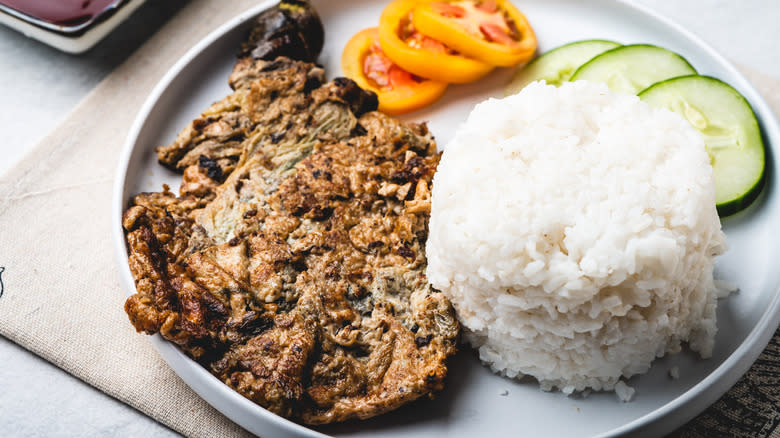Tortang Talong: The Unique Filipino Omelet That's Heavy On The Eggplant

In the Philippines, omelets reign supreme as one of the country's favorite breakfast, lunch, and dinner entrées of choice. However, unlike the classic omelet recipe you might be used to, eggs aren't always the main ingredient, as is the case with one traditional fritter, known as tortang talong. Its name is a mashup of the words omelet or flat cake and eggplant, the latter being the actual star of this savory show. Eggplant is a popular and versatile vegetable featured in some of the best Filipino cuisine, widely enjoyed for its ability to infuse meals with a variety of textures and flavors, depending on the way it's cooked. This vibrantly hued veggie is easily attainable in the Philippines, and when combined with only a couple of other inexpensive ingredients, it's easy to see why tortang talong has become such a national staple.
Thinking about making it yourself? There's no reason to be intimidated, because the simplicity of the Filipino eggplant omelet is one of the best things about it. Maybe you've struggled to get the perfect consistency when cooking the average batch of eggs, and perhaps you've even hunted for every hack out there to learn how to take your omelet to the next level. When making tortang talong, you can throw all that out the window. It's as simple as charring or broiling the eggplant, smashing it flat, and letting a seasoned egg wash work its magic.
Read more: Ingredients To Take Your Scrambled Eggs To The Next Level
Tortang Talong Spotlights The Philippines' Favorite Veggie

While a direct history detailing the origins of tortang talong hasn't been traced, we do know that eggplant grows aplenty in the Philippines. It happens to be the main vegetable crop there, harvested from plots spanning across nearly 50,000 acres that steadily produce nearly 250 thousand metric tons of them each year. Eggplant crops are an important income source for many families, so it comes as no surprise that it's so commonly sautéed, grilled, or fried in other Filipino dishes like kare-kare and pinakbet.
Although both the skin and seeds are edible, you'll want to remove them before making homemade tortang talong. The eggplant can be cooked by grilling it until smoky and blackened, boiling, or roasting. Whichever route you choose, it's important to first score the eggplant with a fork by poking holes all over it. If you skip this step, the superheated water content within the vegetable could cause it to explode, and the only explosions we're hoping for here are flavor-related. After broiling it and stripping away the veggie's violet-colored skin, slicing it lengthwise reveals its white, meaty inner flesh, which is able to soak up other flavors easily. Asian eggplants, specifically, have a slightly sweet, nutty taste and a creamy texture to them that combine nicely when you add salt, slightly acidic ketchup, or umami-rich condiments like soy sauce.
Ingredients Used In Tortang Talong And Variations

The list of ingredients for frying up an eggplant omelet is a short one, but you can always experiment with different spices in this versatile dish. You'll want to use a few eggs to get the job done, especially if the fresh eggplants you find turn out to be massive. It might be challenging to find an actual Filipino eggplant unless you spot some at your local Asian supermarket, but you could find the longer Asian variety at chain grocery stores like Safeway or Kroger. Compared to other types, Asian eggplants are sought after for having fewer seeds, so they taste more sweet than bitter.
When it comes to seasoning your tortang talong, you can choose to keep it simple and stick to trusty salt and pepper, or you can toss in some fancier spices. Some variations call for whisking some garlic, yellow onion, oyster sauce, or even chicken powder into your beaten eggs. If you need to add a little more substance to your eggplant omelet, you can include potatoes or go with a stuffed variation, tortang rellenong, by sauteing up some ground pork or beef with all the basic spices, along with splashes of fish and soy sauces to flavor the meat. It's not unheard of to add seafood to tortang talong either, as some might choose to add tuna or sardines instead of pork.
How To Serve Eggplant Omelets From The Philippines

This easy culinary delicacy is best served with a side of garlic fried rice, known in the Philippines as sinangag, or any type of steamed or fried rice you prefer. The final product is usually eaten with a dollop of ketchup, but you can take it a step further if you're able to procure some banana ketchup, a distinctively sweet specialty sauce full of complex flavors that goes particularly well with tortang talong. And don't worry, it doesn't taste like bananas.
Whether it's tangy ketchup, soy sauce, or a squeeze of lemon that you decide to dress your tortang talong with, be sure not to forget the rice if you're looking to enjoy this traditional Filipino meal to the fullest. And hey, if you've never enjoyed the taste of eggplant recipes before, this dish might change all that. It is fried, after all.
Read the original article on Mashed.

